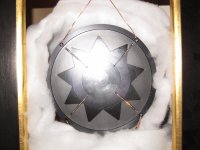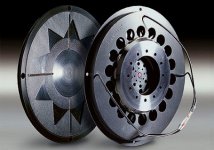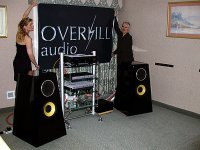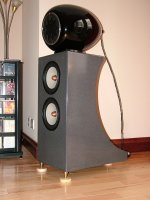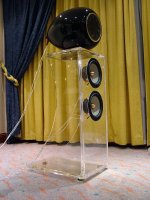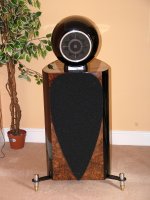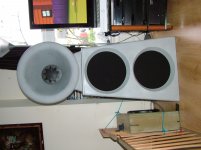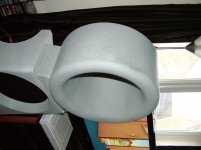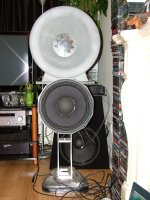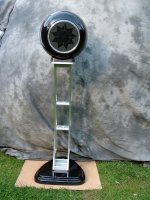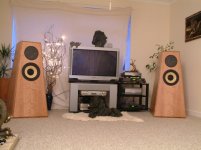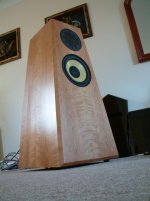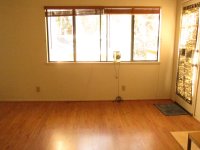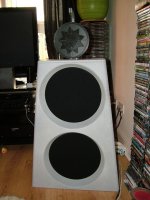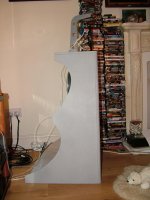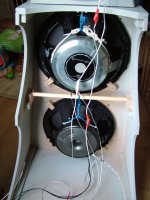D
Deleted member 24284
( This is a thread similar to http://www.diyaudio.com/forums/planars-exotics/245091-re-build-manger-based-system.html, but concentrating purely on the proper enclosure / mounting technique for these unique transducers )
Here is my first cut at an open baffle design, just to listen to them, and to pay my respects to Mr. Linkwitz's excellent ideas. This is obviously not a permanent solution. I don't plan to add a lower-frequency driver to this setup. I intend this to be a single driver, almost-full-range speaker design (at low playback volume only) with no crossover.
It sounds really nice just like this, especially with Annie Haslam singing, or Chick Corea playing the Fender Rhodes electric piano with his various bands over the decades. Imaging is excellent, and the linearity and delicacy of high frequencies is stunning (triangle ding, electric piano's rich overtones, close-miked cellos and flutes).
My goal is actually not an open baffle design. I want to separate the front sound waves from the rear waves. But I don't want a closed enclosure since I want the rear waves to travel freely and die out or get diffused.
I've been thinking of building a half hollow sphere out of DuPont Corian® and then punching a hole in the middle of that half sphere, and mounting the Mangers in that hole. The listener-facing side will have the (spherical) baffle fade away from the ears.
Since the pictures were taken, I have added some Auralex MetroFusor Sound Diffusor to cover the wall behind the Mangers to take care of the rear waves.
Here is my first cut at an open baffle design, just to listen to them, and to pay my respects to Mr. Linkwitz's excellent ideas. This is obviously not a permanent solution. I don't plan to add a lower-frequency driver to this setup. I intend this to be a single driver, almost-full-range speaker design (at low playback volume only) with no crossover.
It sounds really nice just like this, especially with Annie Haslam singing, or Chick Corea playing the Fender Rhodes electric piano with his various bands over the decades. Imaging is excellent, and the linearity and delicacy of high frequencies is stunning (triangle ding, electric piano's rich overtones, close-miked cellos and flutes).
My goal is actually not an open baffle design. I want to separate the front sound waves from the rear waves. But I don't want a closed enclosure since I want the rear waves to travel freely and die out or get diffused.
I've been thinking of building a half hollow sphere out of DuPont Corian® and then punching a hole in the middle of that half sphere, and mounting the Mangers in that hole. The listener-facing side will have the (spherical) baffle fade away from the ears.
Since the pictures were taken, I have added some Auralex MetroFusor Sound Diffusor to cover the wall behind the Mangers to take care of the rear waves.
Attachments
D
Deleted member 24284
They have been around since 1990.
Head office in Germany: Manger Schallwandler
U.K. distributor: Manger Audio
Here is its principle of operation, quoting from their website: (the last sentence is the most important):
In this way the Manger® sound transducer controls the complete frequency range from 80 Hz to 40000 Hz on its surface and is at the same time close to the ideal of the point sound source. The conventional splitting into several ways (tweeter, mid-range and woofer) for different frequency ranges is therefore avoided. The active surface of the 19 cm diameter flexible diaphragm becomes smaller as the frequency increases so that the effective surface is always kept small in comparison to the wavelength to be radiated.
From their FAQ: How does the diaphragm move?
The diaphragm does not move piston-like, as in cone loudspeakers, the flat diaphragm vibrates on its own axis. The bending waves move from the middle outwards, comparable to the wave movement on a water surface after throwing in a stone. Using Mother Nature as as example, the Basilar diaphragm of the human inner ear functions along the same wave principle as the Manger sound transducer. Take a look at the column MSW for more information.
Head office in Germany: Manger Schallwandler
U.K. distributor: Manger Audio
Here is its principle of operation, quoting from their website: (the last sentence is the most important):
In this way the Manger® sound transducer controls the complete frequency range from 80 Hz to 40000 Hz on its surface and is at the same time close to the ideal of the point sound source. The conventional splitting into several ways (tweeter, mid-range and woofer) for different frequency ranges is therefore avoided. The active surface of the 19 cm diameter flexible diaphragm becomes smaller as the frequency increases so that the effective surface is always kept small in comparison to the wavelength to be radiated.
From their FAQ: How does the diaphragm move?
The diaphragm does not move piston-like, as in cone loudspeakers, the flat diaphragm vibrates on its own axis. The bending waves move from the middle outwards, comparable to the wave movement on a water surface after throwing in a stone. Using Mother Nature as as example, the Basilar diaphragm of the human inner ear functions along the same wave principle as the Manger sound transducer. Take a look at the column MSW for more information.
D
Deleted member 24284
Your wood lathe is perfect for making the hollow half sphere baffles I have in mind for the Mangers. I envision 2' diameter. But where can you get such a large piece of wood? Maybe the same method you use to make horns can be adapted to make the hollow half sphere baffle.What kind of tweeter is that??? I've never seen one like that before.
D
Deleted member 24284
Look at the rear of the Manger in the attached picture. It is quite heavily obstructed. I suspect the rear wave, at least at higher frequencies, is quite attenuated compared to the front wave.
My goal is to have the half sphere baffle big enough and the rear of the sphere pointing in the right direction so as to lengthen the reflection path. I'll attenuate the rear wave via absorption material and diffuse it via panels.
One possible arrangement is to suspend the half spheres from the ceiling, with the Mangers pointing at 30 degrees down towards the listener, and about 6" above the top edge of the computer monitor. It's true that this doesn't allow the baffle to be solidly attached to something to damp the vibrations, but the very heavy Corian should be enough to provide adequate damping even when suspended in free space.
Making a spherical baffle is easy with Corian. Just cut concentric rings of the material from a flat sheet, and use those rings to construct a cone by fusing the opposite edges.
My goal is to have the half sphere baffle big enough and the rear of the sphere pointing in the right direction so as to lengthen the reflection path. I'll attenuate the rear wave via absorption material and diffuse it via panels.
One possible arrangement is to suspend the half spheres from the ceiling, with the Mangers pointing at 30 degrees down towards the listener, and about 6" above the top edge of the computer monitor. It's true that this doesn't allow the baffle to be solidly attached to something to damp the vibrations, but the very heavy Corian should be enough to provide adequate damping even when suspended in free space.
Making a spherical baffle is easy with Corian. Just cut concentric rings of the material from a flat sheet, and use those rings to construct a cone by fusing the opposite edges.
Attachments
D
Deleted member 24284
Here is Manger's daughter speaking recently at an audio show: MESSE13: Amazing Monitor Speakers from Manger - YouTube
It's wonderful to hear her voice on my desktop Manger system!
I just found out that Corian can be heated up and molded into different shapes. So I can use that technique to make the half hollow sphere from one sheet of Corian.
It's wonderful to hear her voice on my desktop Manger system!
I just found out that Corian can be heated up and molded into different shapes. So I can use that technique to make the half hollow sphere from one sheet of Corian.
D
Deleted member 24284
I just spoke with a local Corian fabrication house who has a thermal forming oven that can turn a flat sheet into a half hollow sphere to make the baffles.
They will start on the project next month, after the year end rush.
Does anyone want a pair made at the same time?
We have not discussed pricing yet.
Does anyone think this spherical baffle is a bad idea?
In my room, I can shift the furniture slightly so that the back sides of the baffles point towards open windows, thus sending a lot of that out of phase energy out of the room.
They will start on the project next month, after the year end rush.
Does anyone want a pair made at the same time?
We have not discussed pricing yet.
Does anyone think this spherical baffle is a bad idea?
In my room, I can shift the furniture slightly so that the back sides of the baffles point towards open windows, thus sending a lot of that out of phase energy out of the room.
D
Deleted member 24284
Thanks for that. I appreciate it.
If I don't want to use the rear wave to reinforce the bass, will I be better off to diffuse and diffract the rear wave in an open baffle design instead of building a transmission line enclosure to bring the rear wave back into the listening room?
Manger options
Hiya,
I have designed and built 6 different designs using the astonishing Manger driver.
I have used MDF, Birch Ply, Corian, Acrylic, special polymers various hard woods...Phew!
(1) Sealed wooden box,: Heavily braced and damped, built to high standard. Good result, simple construction even with asymmetric internal walls, low build cost, very good WAF, good bang for the buck.
(2) Sealed polymer "Tear Drop": Extreme design and engineering. Stunning performance, stunning looks, massive cost and effort, overall my personal favourite " Desert Island Speaker"
(3) Open Baffle : Suspended " Free Air" design. True sonic reference above
700Hz, limited power handling below that. Very low cost and high WAF. The undiscovered gem of Manger implementation.
(4) Front horn loaded : Massive solid wooden block CNC'd and turned by hand.
On paper its a mess, in reality its fantastic! Horn adds approx. 6dB efficiency to bring the Manger up to 97dB...Really great result, keeps all the natural delicacy and realism. Huge weight ( approx. 35Kg each!), ugly, low WAF, very expensive.
(5) Cardoid / open baffle with rear resistive loading: Great sonic result, not too expensive to build, reasonable WAF, good power handling down to approx. 400Hz.
(6) Rear loaded transmission line : 3.5 meter double folded tapering line with gradually increasing stuffing density. Worst result sonically...Delayed rear wave spoils the unique time coherent Manger principal. Waste of time and money, expensive, big, ugly sounded like a typical muddy two way ported Scan Speak bass mid and dome ( no offense to SS fans!)
Overall:
The Manger is ( in my experience) the best single driver design in the world. It really is unique and recreates sounds in the most natural and beautiful way.
I have attached a few pics and will post a few more, hopefully they will be of some help and interest.
My general conclusions are:
Never use passive crossover components...All caps and inductors are " frequency dependant energy storage devices" ...They ruin the time coherent Manger sound.
Use very good active crossover, ie DEQX or Accurate software / PC based solutions. JRiver plus Fab Filter or similar Pro studio grade stuff.
If used sealed cross it over at 300 to 400Hz.
If used open baffle crossover at approx. 800Hz.
Avoid all ported / rear wave designs.
Can only be run full range at low volumes with programme material with little or no bass...Careful with the volume, I have blown a Manger...It hurts!
Hope some of this helps...Just posting this brings back sweet memories!
Cheers
Derek.
Hiya,
I have designed and built 6 different designs using the astonishing Manger driver.
I have used MDF, Birch Ply, Corian, Acrylic, special polymers various hard woods...Phew!
(1) Sealed wooden box,: Heavily braced and damped, built to high standard. Good result, simple construction even with asymmetric internal walls, low build cost, very good WAF, good bang for the buck.
(2) Sealed polymer "Tear Drop": Extreme design and engineering. Stunning performance, stunning looks, massive cost and effort, overall my personal favourite " Desert Island Speaker"
(3) Open Baffle : Suspended " Free Air" design. True sonic reference above
700Hz, limited power handling below that. Very low cost and high WAF. The undiscovered gem of Manger implementation.
(4) Front horn loaded : Massive solid wooden block CNC'd and turned by hand.
On paper its a mess, in reality its fantastic! Horn adds approx. 6dB efficiency to bring the Manger up to 97dB...Really great result, keeps all the natural delicacy and realism. Huge weight ( approx. 35Kg each!), ugly, low WAF, very expensive.
(5) Cardoid / open baffle with rear resistive loading: Great sonic result, not too expensive to build, reasonable WAF, good power handling down to approx. 400Hz.
(6) Rear loaded transmission line : 3.5 meter double folded tapering line with gradually increasing stuffing density. Worst result sonically...Delayed rear wave spoils the unique time coherent Manger principal. Waste of time and money, expensive, big, ugly sounded like a typical muddy two way ported Scan Speak bass mid and dome ( no offense to SS fans!)
Overall:
The Manger is ( in my experience) the best single driver design in the world. It really is unique and recreates sounds in the most natural and beautiful way.
I have attached a few pics and will post a few more, hopefully they will be of some help and interest.
My general conclusions are:
Never use passive crossover components...All caps and inductors are " frequency dependant energy storage devices" ...They ruin the time coherent Manger sound.
Use very good active crossover, ie DEQX or Accurate software / PC based solutions. JRiver plus Fab Filter or similar Pro studio grade stuff.
If used sealed cross it over at 300 to 400Hz.
If used open baffle crossover at approx. 800Hz.
Avoid all ported / rear wave designs.
Can only be run full range at low volumes with programme material with little or no bass...Careful with the volume, I have blown a Manger...It hurts!
Hope some of this helps...Just posting this brings back sweet memories!
Cheers
Derek.
Attachments
Manger " Finale"
This was an absolute beast to build, but OMG it sounded fab...
Beyma Pro 12 inch driver : 20Hz to 100Hz, in sealed Corian box
Volt BM 2500.4 : 100Hz to 400Hz in VPL open baffle.
Manger 400Hz up : Sealed polymer teardrop cabinet with multiple layers of 5 different dampening materials and 3 different soft fibre stuffing.
Controlled by ultra modified DEQX and 6 channel DAC in a twin box design incorporated with Sistrum rack....Exhaustive development and engineering...So glad I am not in the ultra high end game any more!
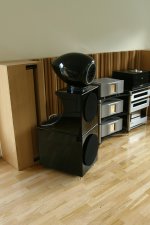
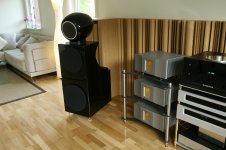
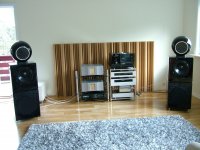
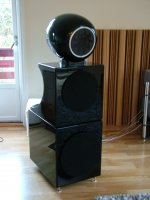 D.
D.
This was an absolute beast to build, but OMG it sounded fab...
Beyma Pro 12 inch driver : 20Hz to 100Hz, in sealed Corian box
Volt BM 2500.4 : 100Hz to 400Hz in VPL open baffle.
Manger 400Hz up : Sealed polymer teardrop cabinet with multiple layers of 5 different dampening materials and 3 different soft fibre stuffing.
Controlled by ultra modified DEQX and 6 channel DAC in a twin box design incorporated with Sistrum rack....Exhaustive development and engineering...So glad I am not in the ultra high end game any more!



 D.
D.
D
Deleted member 24284
Overkill, thanks for sharing.
I am glad you found your #3 to be the best. But it isn't really open baffle, according to your pictures, since it has a tear drop rear enclosure? The open baffle designs make use of cancellation between front and rear waves to limit side-ways radiation. Your rear wave is 100% trapped.
But I love the whole idea of overkill.
Once I have those Corian half hollow spheres made, with Manger mounted in the middle, I have an overkill proposal on how to use them: let the rear wave radiate unobstructed to the outside, leaving the room forever. I'll mount those half spheres on the two window openings shown in my picture (left-most and right-most sections out of the four), with a sheet of wood or Corian helping to fit them exactly to the window. This means the Mangers will mount off-center in the spheres since I need some toe-in.
Then, the bass will use the floor and wall room boundaries as reinforcements, Klipsch style, but with the rear wave trapped in a closed enclosure. I haven't figured out how to do this yet, since the speakers must be placed at a 45 degree angle very close to the intersection of the two surfaces (floor and wall), so the enclosure to trap the rear wave must be positioned somewhere else near by in such a way as to not affect the front radiation. Or I can copy the Klipsch folded horn idea (rotated 90 degrees) so that the front wave bounce a few times before entering the room at exactly the right positions, but the rear wave is not trapped in a large enough enclosure so that won't be good for either the sound or the efficiency.
I am glad you found your #3 to be the best. But it isn't really open baffle, according to your pictures, since it has a tear drop rear enclosure? The open baffle designs make use of cancellation between front and rear waves to limit side-ways radiation. Your rear wave is 100% trapped.
But I love the whole idea of overkill.
Once I have those Corian half hollow spheres made, with Manger mounted in the middle, I have an overkill proposal on how to use them: let the rear wave radiate unobstructed to the outside, leaving the room forever. I'll mount those half spheres on the two window openings shown in my picture (left-most and right-most sections out of the four), with a sheet of wood or Corian helping to fit them exactly to the window. This means the Mangers will mount off-center in the spheres since I need some toe-in.
Then, the bass will use the floor and wall room boundaries as reinforcements, Klipsch style, but with the rear wave trapped in a closed enclosure. I haven't figured out how to do this yet, since the speakers must be placed at a 45 degree angle very close to the intersection of the two surfaces (floor and wall), so the enclosure to trap the rear wave must be positioned somewhere else near by in such a way as to not affect the front radiation. Or I can copy the Klipsch folded horn idea (rotated 90 degrees) so that the front wave bounce a few times before entering the room at exactly the right positions, but the rear wave is not trapped in a large enough enclosure so that won't be good for either the sound or the efficiency.
Attachments
- Status
- This old topic is closed. If you want to reopen this topic, contact a moderator using the "Report Post" button.
- Home
- Loudspeakers
- Planars & Exotics
- Manger open baffle mounting techniques

